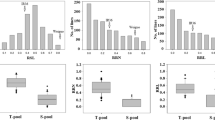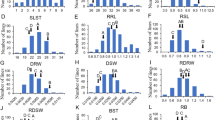Abstract
Identification of genes for quantitative traits is difficult using any single approach due to complex inheritance of the traits and limited resolving power of the individual techniques. Here a combination of genetic mapping and bulked transcriptome profiling was used to narrow down the number of differentially expressed salt-responsive genes in rice in order to identify functional polymorphism of genes underlying the quantitative trait loci (QTL). A population of recombinant inbred lines (RILs) derived from cross between salt-tolerant variety CSR 27 and salt-sensitive variety MI 48 was used to map QTL for salt ion concentrations in different tissues and salt stress susceptibility index (SSI) for spikelet fertility, grain weight, and grain yield. Eight significant QTL intervals were mapped on chromosomes 1, 8, and 12 for the salt ion concentrations and a QTL controlling SSI for spikelet fertility was co-located in one of these intervals on chromosome 8. However, there were total 2,681 genes in these QTL intervals, making it difficult to pinpoint the genes responsible for the functional differences for the traits. Similarly, transcriptome profiling of the seedlings of tolerant and sensitive parents grown under control and salt-stress conditions showed 798 and 2,407 differentially expressed gene probes, respectively. By analyzing pools of RNA extracted from ten each of extremely tolerant and extremely sensitive RILs to normalize the background noise, the number of differentially expressed genes under salt stress was drastically reduced to 30 only. Two of these genes, an integral transmembrane protein DUF6 and a cation chloride cotransporter, were not only co-located in the QTL intervals but also showed the expected distortion of allele frequencies in the extreme tolerant and sensitive RILs, and therefore are suitable for future validation studies and development of functional markers for salt tolerance in rice to facilitate marker-assisted breeding.


Similar content being viewed by others
References
Ammar MHM, Pandit A, Singh RK, Sameena S, Chauhan MS, Singh AK, Sharma PC, Gaikwad K, Sharma TR, Mohapatra T, Singh NK (2009) Mapping of QTLs controlling Na+, K+ and Cl− ion concentrations in salt tolerant indica rice variety CSR27. J Plant Biochem Biotechnol 18:139–150
Amrutha RN, Sekhar PN, Varshney RK, Kishor PBK (2007) Genome-wide analysis and identification of genes related to potassium transporter families in rice (Oryza sativa L.). Plant Sci 172:708–721
Benjamini Y, Hochberg Y (1995) Controlling the false discovery rate: a practical and powerful approach to multiple testing. J R Stat Soc Ser B 57:289–300
Bonilla P, Dvorak J, Mackill D, Deal K, Gregorio G (2002) RFLP and SSLP mapping of salinity tolerance genes in chromosome 1 of rice (Oryza sativa L.) using recombinant inbred lines. Philipp Agric Sci 85:68–76
Brumos J, Colmenero-Flores JM, Conesa A, Izquierdo P, Sánchez G, J-Iglesias D, López-Climent MF, Gómez-Cadenas A, Talon M (2009) Membrane transporters and carbon metabolism implicated in chloride homeostasis differentiate salt stress responses in tolerant and sensitive Citrus rootstocks. Funct Integr Genomics 9:293–309
Cakmak I (2005) The role of potassium in alleviating detrimental effects of abiotic stresses in plants. J Plant Nutr Soil Sci 168:521–530
Colmenero-Flores MJ, Martinez G, Gamba G, Va’zquez N, Lglesias DJ, Brumo J, Talo M (2007) Identification and functional characterization of cation-chloride cotransporters in plants. Plant J 50:278–292
Doerge RW, Churchill GA (1996) Permutation tests for multiple loci affecting a quantitative character. Genetics 142:285–294
Fischer RA, Maurer R (1978) Drought resistance in spring wheat cultivars. I. Grain yield responses. Aust J Agric Res 29:897–912
Giovannoni JJ, Wing RA, Ganal MW, Tanksley SD (1991) Isolation of molecular markers from specific chromosomal intervals using DNA pools from existing mapping populations. Nucleic Acids Res 19(23):6553–6555
Gong JM, He P, Qian Q, Shen LS, Zhu LH, Chen SY (1999) Identification of salt-tolerance QTL in rice (Oryza sativa L.). Chin Sci Bull 44:68–71
Gregorio GB (1997) Tagging salinity tolerance genes in rice using amplified fragment length polymorphism (AFLP). PhD thesis, Univ Philippines, Los Banos, Philippines
Heazlewood JL, Howell KA, Whelan J, Millar AH (2003) Towards an analysis of the rice mitochondrial proteome. Plant Physiol 132(1):230–242
IRGSP (2005) The map based sequence of the rice genome. Nature 436:793–800
Jain M, Nijhawan A, Tyagi AK, Khurana JP (2006) Validation of housekeeping genes as internal control for studying gene expression in rice by quantitative real-time PCR. Biochem Biophys Res Commun 345:646–651
Kathiresan A, Lafitte HR, Chen J, Mansueto L, Bruskiewich R, Bennett J (2006) Gene expression microarray and their application in drought stress research. Field Crops Res 97:101–110
Kawasaki S, Borchert C, Deyholos M, Wang H, Brazille S, Kawai K, Galbraith D, Bohnert HJ (2001) Gene expression profiles during the initial phase of salt stress in rice. Plant Cell 13:889–905
Korol A, Ronin Y, Itzcovich A, Nevo E (2001) Enhanced efficiency of QTL mapping analysis based on multivariate complexes of quantitative traits. Genetics 157:1789–1803
Kosambi DD (1944) The estimation of map distance from recombination values. Ann Eugen 12:172–175
Koyama ML, Aurora L, Koebner RMD, Flowers TJ, Yeo AR (2001) Quantitative trait loci for component physiological traits determining salt tolerance in rice. Plant Physiol 125:406–422
Kushwaha HR, Singh AK, Sopory AK, Singla-Pareek SL, Pareek A (2009) Genome wide expression analysis of CBS domain containing proteins in Arabidopsis thaliana (L.) Heynh and Oryza sativa L. reveals their developmental and stress regulation. BMC Genomics 10:200
Lanceras JC, Pantuwan G, Jongdee B, Toojinda T (2004) Quantitative trait loci associated with drought tolerance at reproductive stage in rice. Plant Physiol 135:384–399
Lin HX, Zhu MZ, Yano M, Gao JP, Liang ZW, Su WA, Hu XH, Ren ZH, Chao DY (2004) QTLs for Na + and K + uptake of the shoots and roots controlling rice salt tolerance. Theor Appl Genet 108:253–260
Lin HX, Yangihara S, Zhuang JY, Senboku T, Zheng KL, Yashima S, Lin HX, Zhuang JY, Zheng KL (1997) Mapping of QTL for salt tolerance in rice (Oryza sativa L.) via molecular markers. Chin Rice Res Newslett 5(4):1–2
Marino R, Ponnaiah M, Krajewski P, Frova C, Gianfranceschi L, Pe EM, Gorla SM (2009) Addressing drought tolerance in maize by transcriptional profiling and mapping. Mol Genet Genomics 218:163–179
Michelmore RW, Paran I, Kesseli RV (1991) Identification of markers linked to disease-resistance genes by bulked segregant analysis: a rapid method to detect markers in specific genomic regions by using segregating populations. Proc Natl Acad Sci USA 88(21):9828–9832
Murray MG, Thompson WF (1980) Rapid isolation of high molecular weight plant DNA. Nucleic Acids Res 8:4321–3425
Prasad SR, Bagali PG, Shailaja H, Shashidhar HE, Hittalmani S (2000) Molecular mapping of quantitative trait loci associated with seedling tolerance to salt stress in rice (Oryza sativa L.). Curr Sci 78:162–164
Price A (2006) Believe it or not, QTLs are accurate!. Trends Plant Sci 11:213–216
Ren ZH, Gao JP, Li LG, Cai XL, Huang W, Chao DY, Zhu MZ, Wang ZY, Luan S, Lin HX (2005) A rice quantitative trait locus for salt tolerance encodes a sodium transporter. Nat Genet 37:1141–1146
Sabouri H, Sabouri A (2008) New evidence of QTLs attributed to salinity tolerance in rice. Afr J Biotechnol 7:4376–4388
Sahi C, Singh A, Kumar K, Blumwald E, Grover A (2006) Salt stress response in rice: genetics, molecular biology, and comparative genomics. Funct Integr Genomics 6:263–284
Salvi S, Tuberosa R (2005) To clone or not to clone plant QTLs: present and future challenges. Trends Plant Sci 10:297–304
Sanan-Mishra N, Pham XH, Sopory SK, Tuteja N (2005) Pea DNA helicase 45 overexpression in tobacco confers high salinity tolerance without affecting yield. Proc Natl Acad Sci USA 102:509–514
Singh RK, Mishra B (2004) Role of Central Soil Salinity Research Institute in Genetic improvement of rice varieties in India. In: Sharma SD, Rao UP (eds) Genetic improvement of rice varieties in India, pp 189–242
Singh H, Deshmukh RK, Singh A, Singh AK, Gaikward K, Sharma TR, Mohapatra T, Singh NK (2010) Highly variable SSR markers suitable for rice genotyping using agarose gels. Mol Breed 25:359–364
Sweetlove LJ, Heazlewood JL, Herald V, Holtzapffel R, Day DA, Leaver CJ, Millar AH (2002) The impact of oxidative stress on Arabidopsis mitochondria. Plant J 32(6):891–904
Tanji KK (1990) Nature and extent of agricultural salinity. In: Tanji KK (ed) Agricultural salinity assessment and management 71, pp 1–17
Thomson MJ, Ocampo DM, Egdane J, Katimbang M, Singh RK, Gregorio G, Ismail M (2007) QTL mapping and marker assisted backcrossing for improved salinity tolerance in rice. In: Plant and animal genomes XV conference, San Diego, CA, 13–17 January 2007
Walia H, Wilson C, Condamine P, Liu X, Ismail AM, Zeng L, Wanamaker SI, Mandal Xu J, Cui X, Close TJ (2005) Comparative transcriptional profiling of two contrasting rice genotypes under salinity stress during the vegetative growth stage. Plant Physiol 139:822–835
Walia H, Wilson C, Zeng L, Ismail AM, Condamine P, Close TJ (2007) Genome-wide transcriptional analysis of salinity stressed japonica and indica rice genotypes during panicle initiation stage. Plant Mol Biol 63:609–623
Wang S, Basten CJ, Zeng ZB (2007) Windows QTL cartographer 2.5. http://statgen.ncsu.edu/qtlcart/WQTLCart.htm
Wayne ML, Mcintyre LM (2002) Combining mapping and arraying: an approach to candidate gene identification. Proc Natl Acad Sci USA 99:14903–14906
Wu R, Garg A (2003) Engineering rice plants with trehalose-producing genes improves tolerance to drought, salt and low temperature. ISBN News Report, February 2003. http://www.isb.vt.edu/
Xinjian H, Jianquan C, Zhigang Z, Jinsong Z, Chen Shouyi (2002) Identification of salt-stress responsive genes in rice (Oryza sativa L.) by cDNA array. Sci China Ser C Life Sci 45:477–484
Yamagami M, Haga K, Napier RM, Lino M (2004) Two distinct signaling pathways participate in auxin-induced swelling of pea epidermal protoplasts. Plant Physiol 134:735–747
Yoshida S, Forna DA, Kock JH, Gomez KA (1972) Laboratory manual for physiological studies of rice. IRRI, Manila, p 34
Zang JP, Sun Y, Wang Y, Yang J, Li F, Zhou YL, Zhu LH, Jessica R, Mohammadhosein F, Xu JL, Li ZK (2008) Dissection of genetic overlap of salt tolerance QTLs at the seedling and tillering stages using backcross introgression lines in rice. Sci China Ser C Life Sci 51:583–591
Zeng ZB (1993) Theoretical basis of separation of multiple linked gene effects on mapping quantitative trait loci. Proc Natl Acad Sci USA 90:10972–10976
Zeng ZB (1994) Precision mapping of quantitative trait loci. Genetics 136:1457–1468
Zhang GY, Guo Y, Chen SL, Chen SY (1995) RFLP tagging of a salt tolerance gene in rice. Plant Sci 110:227–234
Zhu J-K, Liu J, Xiong L (1998) Genetic analysis of salt tolerance in Arabidopsis thaliana: evidence of a critical role for potassium nutrition. Plant Cell 10:1181–1192
Acknowledgments
We are thankful to the Indian Council of Agricultural Research, New Delhi, for financial support of the NPTC project.
Author information
Authors and Affiliations
Corresponding author
Additional information
Communicated by R. Waugh.
Electronic supplementary material
Below is the link to the electronic supplementary material.
Rights and permissions
About this article
Cite this article
Pandit, A., Rai, V., Bal, S. et al. Combining QTL mapping and transcriptome profiling of bulked RILs for identification of functional polymorphism for salt tolerance genes in rice (Oryza sativa L.). Mol Genet Genomics 284, 121–136 (2010). https://doi.org/10.1007/s00438-010-0551-6
Received:
Accepted:
Published:
Issue Date:
DOI: https://doi.org/10.1007/s00438-010-0551-6




